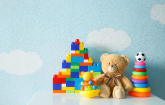The Toy Association Urges Families to Follow Important Tips for Safe Play
National Survey Reveals 96% of Parents Don't Follow Toy's Age Label & Other Concerning Findings
NEW YORK, Nov. 12, 2019 /PRNewswire/ -- With the holiday shopping season here, it can be easy to get wrapped up in the frenzy of buying gifts and overlook safety. But The Toy Association is urging parents, grandparents, and other gift givers to ensure their kids stay safe by following important safety tips – not just leading up to the holidays, but all year long.
Experience the interactive Multichannel News Release here: https://www.multivu.com/players/English/8646351-the-toy-association-important-safety-tips/
"U.S. toy safety standards are among the strictest in the world. Before reaching your house, toys are subject to over a hundred safety standards and tests and must be certified compliant by a third-party testing lab," said Joan Lawrence, senior vice president of standards and regulatory affairs at The Toy Association. "While parents can rest assured that toys and games sold by legitimate retailers are safe, children's safety is a shared responsibility. We urge parents to visit PlaySafe.org for tips to ensure every play date is a safe one."
- Age Grading
An alarming 96 percent of parents are confident that their children can play with a toy even if they are younger than the toy's age recommendation, according to a recent survey of 1,000 U.S. parents conducted by Wakefield Research on behalf of The Toy Association.* But the age-grading on a toy isn't related to how smart a child is or merely a suggestion — it's based on the developmental abilities of kids at a given age and the specific features of a toy. When children play with a toy above their age grade, they might misuse the toy and get hurt. Age grading is found directly on toy packaging or in the product descriptions for all legitimate toys sold online. - Small Parts
Pay special attention to toys labeled 3+, since these toys may contain small parts that can be a choking hazard for children under three (or kids who still mouth toys). Toys with small parts will be labeled, so keep a careful eye out as you shop, and consider getting a Small Parts Tester (available in the baby-proofing section of most toy stores) to test other small objects found around the home. - Counterfeits
Thirty-four percent (34%) of toy-buying parents don't know that fake toys – which might be sold on major online marketplaces by unverified third-party sellers – are not always tested for safety. On the other hand, legitimate toys sold by responsible sellers comply with more than 100 federal standards and tests to ensure children's safety. Always dig deeper into a lesser-known online seller's history and reviews to determine their legitimacy before making your purchase. You can also make your purchase directly on a brand's website or follow the provided links to official retailers selling their products. - Household Dangers
Kids can find ways to play with anything – including objects that are not toys, like small powerful magnets (found in executive desk toys) or button cell batteries (from remotes, hearing aids, and so on). These objects are not meant to be played with and can be very dangerous if accidentally swallowed. Always keep them out of children's reach.
Parents are encouraged to share these tips with grandparents and other gift-givers and to supervise children and demonstrate safe play.
"Showing little ones how to properly use a toy or game is the best way to make sure they understand how to safely enjoy it. Best of all, playing together as a family is lots of fun and even has enhanced developmental benefits for children," added Lawrence.
The Toy Association and its members take toy safety extremely seriously and are committed year-round to educating parents and caregivers about safe play. Following this simple safety advice can go a long way toward preventing unnecessary accidents and injuries.
For more toy safety tips and information, visit www.PlaySafe.org, The Toy Association's trusted resource for parents and caregivers.
About The Toy Association www.toyassociation.org / www.thegeniusofplay.org / www.playsafe.org
Founded in 1916, The Toy Association™, Inc. is the not-for-profit trade association representing all businesses involved in creating and delivering toys and youth entertainment products for kids of all ages. The Toy Association leads the health and growth of the U.S. toy industry, which has an annual U.S. economic impact of $110.9 billion, and its 1,000+ members drive the annual $28 billion U.S. domestic toy market. The Toy Association serves as the industry's voice on the developmental benefits of play, and promotes play's positive impact on childhood development to consumers and media. The organization has a long history of leadership in toy safety, having helped develop the first comprehensive toy safety standard more than 40 years ago, and remains committed to working with medical experts, government, consumers, and industry on ongoing programs to ensure safe and fun play.
As a global leader, The Toy Association produces the world-renowned North American International Toy Fair and Fall Toy Preview; advocates on behalf of members around the world; sustains the Canadian Toy Association; acts as secretariat for the International Council of Toy Industries and International Toy Industry CEO Roundtable; and chairs the committee that reviews and revises America's widely emulated ASTM F963 toy safety standard.
SOURCE The Toy Association

Related Links
WANT YOUR COMPANY'S NEWS FEATURED ON PRNEWSWIRE.COM?
Newsrooms &
Influencers
Digital Media
Outlets
Journalists
Opted In





Share this article